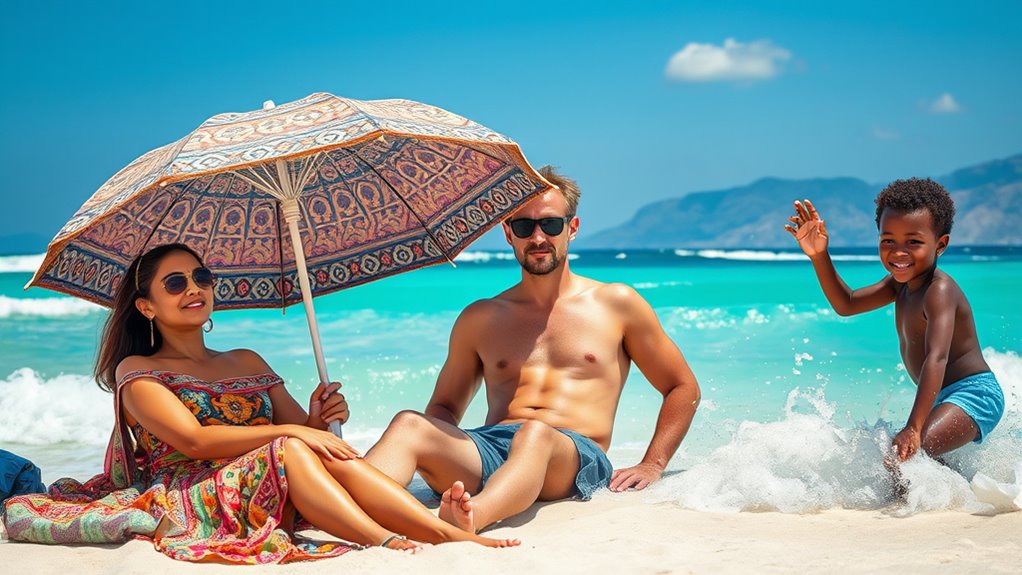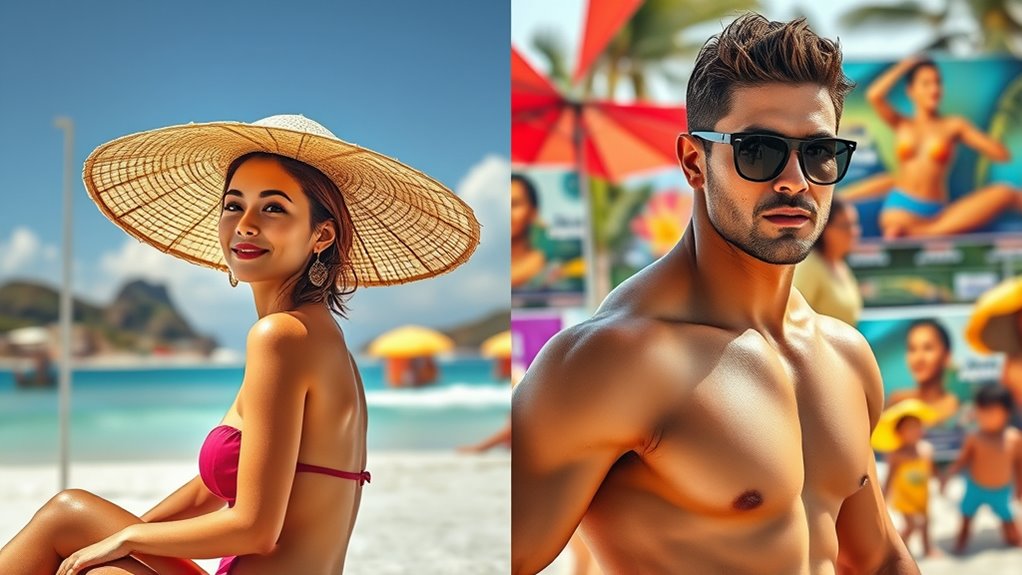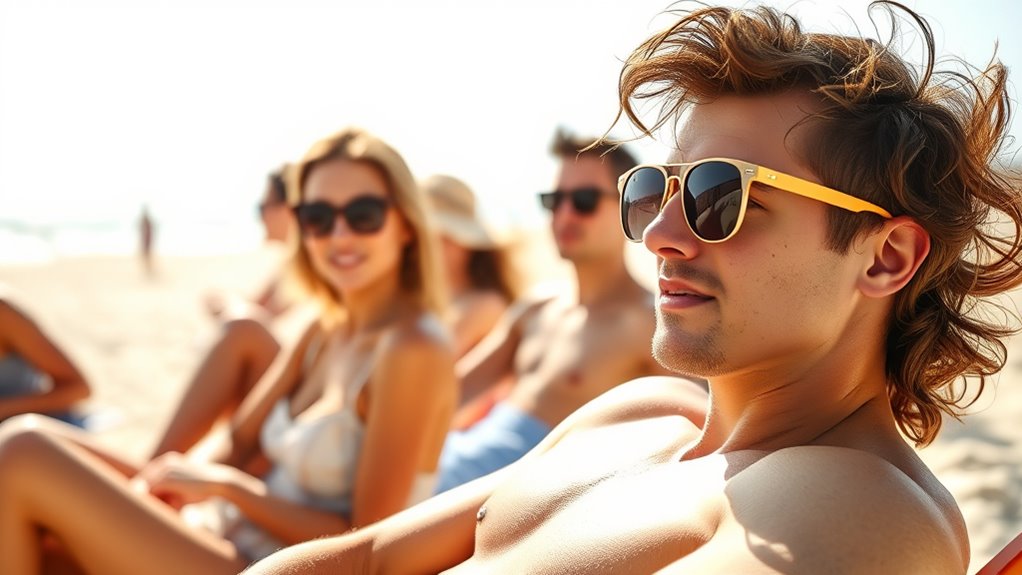In different societies, tanning signifies various things—while Western cultures often see a sun-kissed glow as a sign of vitality and leisure, many Asian nations prioritize fair skin as a symbol of beauty and social status. Latin America celebrates bronzed, radiant skin as vibrant and attractive, whereas Middle Eastern norms favor skin covering and sun protection. These perceptions are shaped by history, culture, and media, and exploring further reveals how social pressures influence your views on skin color and beauty.
Key Takeaways
- In Western societies, tanning is associated with health, vitality, and attractiveness, influenced by media and celebrity trends.
- Asian cultures typically value fair skin as a symbol of beauty and social status, promoting sun avoidance and whitening products.
- Latin American societies often see tanned, bronzed skin as vibrant, attractive, and a sign of outdoor vitality and leisure.
- Middle Eastern norms favor fair skin, with cultural practices emphasizing skin covering and sun protection to maintain beauty standards.
- African perceptions vary, with some cultures celebrating darker skin as natural beauty, while others follow Western-influenced ideals.
Historical Origins of Tanning and Skin Color Preferences

Understanding the historical origins of tanning and skin color preferences reveals how societal values have evolved over time. In ancient societies, pale skin symbolized wealth and high status since aristocrats rarely labored outdoors. The color of your skin indicated social standing; paleness meant you were affluent, while tans signaled manual labor. Beauty standards historically favored fair skin, associating it with elegance and privilege. Geography and climate also influenced preferences—sunny regions naturally led to darker skin tones, which became desirable in some cultures. Skin tone often served as an economic marker, with lighter skin reflecting indoor work and wealth. Additionally, the perception of tanning as a sign of beauty has been reinforced by media and fashion trends in modern times. The rise of industrialization and urban lifestyles further shifted beauty ideals, emphasizing a leisurely lifestyle associated with tanned skin. Recognizing the ancient use of body adornment helps us understand how these perceptions originated and persisted through history.
Western Perspectives: From Labor Marker to Symbol of Leisure

In the early 20th century, societal attitudes toward tanning began to shift dramatically. Tanned skin moved from being associated with manual labor and lower classes to a symbol of leisure and luxury. Celebrities like Coco Chanel popularized the tan after sun exposure on a yacht, making it fashionable. As fashion evolved, shorter hemlines and outdoor activities became common, making tanned skin more visible and desirable. Magazines promoted tanning as glamorous and a sign of health and vitality. Over time, health concerns about sun damage emerged, leading people to favor fair skin again or seek sunless alternatives. Today, a tan often signifies an active lifestyle, wealth, and attractiveness, reflecting leisure, travel, and social status in Western culture.
Cultural Significance of Fair Skin in Asian Societies

In many Asian societies, the preference for fair skin has deep historical and social roots, shaping cultural ideals of beauty and status. Historically, fair skin signified wealth and privilege because it indicated an elite, indoor lifestyle, while darker skin associated with outdoor labor and rural poverty. Colonial influences and Western beauty standards further reinforced this preference. Classical literature often describes heroines with radiant, pale complexions, symbolizing virtue and elegance. Today, media, especially Korean dramas, popularize fair skin as a beauty ideal, while the cosmetics industry offers extensive skin-whitening products. Social pressures encourage people to avoid sun exposure and adopt routines to maintain lighter skin. Additionally, the desire for social acceptance drives many to conform to these beauty standards, reinforcing their significance in society. Airless paint sprayers are a modern example of innovative tools that enhance efficiency and quality in painting projects. Fair skin continues to symbolize success, purity, and social distinction, deeply ingrained in cultural norms across many Asian societies.
Gender Influences and Social Pressures in Tanning Practices

Gender plays a significant role in shaping tanning practices and the social pressures surrounding them. You’ll notice women tend to tan more often than men, partly because societal standards associate tanned skin with attractiveness, especially for women. Women often seek tanning to appeal to romantic partners and gain social approval, influenced by compliments and peer encouragement. Social norms during adolescence reinforce these behaviors, making tanning a symbol of beauty and success for women. *Notably*, women are more aware of health risks but often prioritize appearance over safety. Men, on the other hand, underestimate sun dangers and are less likely to use sunscreen. Their tanning habits are less influenced by social pressures, and risk-taking behaviors tend to be more prominent in their choices. Additionally, the horsepower of electric dirt bikes and other related personal preferences can influence how individuals engage in outdoor activities that might involve sun exposure. Furthermore, the nutritional content of certain foods may also impact skin health and tanning outcomes, subtly affecting perceptions of beauty and health. A home theatre projector with adjustable settings can enhance indoor tanning simulations for aesthetic purposes, which some individuals find appealing. Recognizing the influence of dog breeds and their traits can also shape outdoor activity choices, as some breeds are more active outdoors and may impact sun exposure patterns. Moreover, understanding home organization techniques can motivate individuals to create environments that support healthier lifestyle choices, including safe sun practices.
Impact of Health Concerns on Tanning Trends Worldwide

Growing awareness of the health risks associated with indoor tanning has considerably influenced global trends. You’re now more informed about how indoor tanning is classified as a Group 1 carcinogen by the WHO, increasing your concern about skin cancer. Evidence shows that tanning is linked to over 3,400 melanoma cases annually in Europe and more than 170,000 non-melanoma skin cancers in the U.S., especially when started young. As a result, many countries have enacted laws to restrict tanning practices, and public health campaigns aim to change societal perceptions of beauty. You see a shift toward sunless alternatives, driven by health fears and environmental factors. Additionally, efforts to enhance public awareness about the dangers of tanning continue to influence behavior change. The increasing availability of healthier options such as self-tanning products has made it easier for people to adopt safer beauty routines. Research on behavioral change indicates that increasing understanding of health risks can significantly reduce risky behaviors. For example, some communities are actively promoting natural skin tones as a beauty standard to challenge traditional tanning ideals. Moreover, the rise of digital media has amplified messages about skin health, encouraging individuals to prioritize long-term well-being over temporary aesthetic gains. Overall, increased awareness is reducing tanning’s popularity and prompting healthier attitudes worldwide.
Regional Variations: Tanning Attitudes Across Continents

Different regions around the world hold contrasting views on tanning, shaped by cultural, historical, and environmental factors. In North America and Europe, tanned skin once symbolized luxury and leisure, but health concerns shifted perceptions, linking fair skin with sophistication and warning against skin damage. Despite this, many young adults still seek tans for appearance and emotional reasons, often influenced by beauty standards that emphasize a bronzed look. In Asia, fair skin remains a symbol of beauty and social status, with sun avoidance and whitening products dominant. Tanning is associated with lower socioeconomic status, though globalization introduces some interest in bronzed looks. Latin America celebrates tanned, bronzed skin as a sign of vitality and attractiveness, encouraged by outdoor lifestyles. Meanwhile, the Middle East values fair skin, with cultural norms promoting skin covering and sun protection. In Africa, perceptions vary widely, with some groups valuing darker skin as natural beauty, reflecting diverse cultural attitudes towards skin color. Additionally, understanding creative practice can provide insights into how different societies develop their unique beauty standards and cultural expressions related to skin and appearance. Exploring social perceptions reveals how historical contexts influence societal attitudes toward tanning and skin color. Furthermore, the influence of sound design techniques can help analyze how visual and tactile cues shape societal perceptions of beauty and health. Recognizing these diverse perspectives highlights the importance of cultural sensitivity in discussions of beauty and body image worldwide.
The Role of Media and Globalization in Shaping Beauty Standards

Have you ever wondered how media shapes our ideas of beauty and influences our desire for tanned skin? Media, especially women’s magazines and social media, play a significant role by constantly showcasing tanned models and celebrities as symbols of attractiveness and fitness. These images cultivate the belief that a tan is desirable, making tanned skin seem normal and aspirational over time. Celebrities act as role models, encouraging fans to emulate their sun-kissed look, often despite health risks. Social media amplifies these trends, spreading “golden glow” images among younger audiences and creating social pressure to conform. However, it also offers platforms for anti-tanning campaigns, promoting skin health. Media literacy helps you recognize manipulated images and resist harmful beauty standards rooted in tanning ideals. Additionally, the diverse world of halal lifestyles emphasizes natural beauty and skin health, encouraging more inclusive and health-conscious beauty standards. Understanding the private placement memorandum process can help investors assess emerging beauty and health markets more effectively. Recognizing media influence as a factor in shaping beauty standards can empower individuals to make healthier choices and challenge unrealistic ideals. Moreover, awareness of financial regulations related to health and beauty industries can further inform consumers and investors alike.
Psychological and Social Drivers Behind Tanning Behaviors

Media and cultural standards heavily influence why people pursue tanning, but psychological and social factors also play a key role. You might find yourself driven by internal struggles like depression or body dissatisfaction, which can increase your urge to tan as a way to feel better or improve your appearance. For some, tanning becomes an addiction, with symptoms such as irritability or tension when they can’t tan, often linked to obsessive-compulsive traits. Social influences also matter; you may tan to emulate celebrities, compete with others, or boost your romantic appeal. Intrasexual rivalry and perceptions of attractiveness motivate longer tanning sessions, despite health risks. These psychological and social drivers often operate beneath conscious awareness, reinforcing tanning behaviors as a way to fulfill deeper needs related to self-esteem, social acceptance, and romantic success. Utilizing aesthetic hooks and wall organization may also reflect underlying desires for order and visual appeal, which can subtly influence tanning choices and overall self-presentation.
Frequently Asked Questions
How Do Socioeconomic Factors Influence Tanning Preferences Globally?
You can see that socioeconomic factors shape tanning preferences worldwide. Higher socioeconomic groups often have better access to sunless tanning products and facilities, making safe options more popular. Meanwhile, lower-income individuals might use tanning to signal status or leisure. Cost, convenience, and health awareness also influence choices, with wealthier groups more likely to indulge in tanning as a beauty standard, while others may avoid sun exposure due to health concerns.
Are There Traditional Rituals Associated With Tanning in Any Cultures?
You’ll find that many cultures have traditional rituals linked to tanning, often holding deep spiritual or cultural meaning. For example, indigenous groups use specific tanning techniques in ceremonies to honor ancestors or mark important events. These rituals preserve their heritage and connect community members to their history. By participating or learning about these practices, you can gain insight into how tanning extends beyond craftsmanship to serve as a essential cultural tradition.
How Do Religious Beliefs Impact Attitudes Toward Skin Color and Tanning?
Religious beliefs shape your views on skin color and tanning by emphasizing inner qualities over physical appearance. You might see spiritual beauty as more important, which reduces the value placed on skin tone or tanning practices. In some communities, religious teachings promote equality and challenge colorism, encouraging you to focus on virtues instead of superficial traits. This influence can lead you to perceive tanning or skin color as less significant in your cultural or spiritual identity.
What Role Do Age and Generational Gaps Play in Tanning Behaviors?
You might find it surprising that indoor tanning drops from 20.4% among 18-29-year-olds to just 7.8% in those over 65. Age and generational gaps strongly influence tanning behaviors—young adults often see it as fashionable, while older adults tend to avoid it due to health concerns. Social influences, media, and changing priorities shape these differences, making tanning habits vary markedly across generations.
How Do Immigrant Communities Navigate Contrasting Tanning Ideals?
You see, immigrant communities often grapple with conflicting tanning ideals. Traditional cultures value lighter skin, while Western societies admire tanned skin as attractive and healthy. As you become more acculturated, you might adopt local norms, leading you to tan more. However, some may stick to their original ideals, avoiding tanning altogether. Social influences, peer pressure, and media play key roles, making it a complex balancing act between preserving culture and fitting in.
Conclusion
Your perception of tanning reveals how society paints beauty with broad strokes—sometimes as a symbol of leisure, other times as a mark of health or social status. As you navigate these diverse views, remember that your skin is more than a canvas; it’s a story of history, culture, and identity. Embrace your unique glow, knowing it reflects more than just outward appearance—it’s a reflection of your inner world and the world’s evolving ideals.





